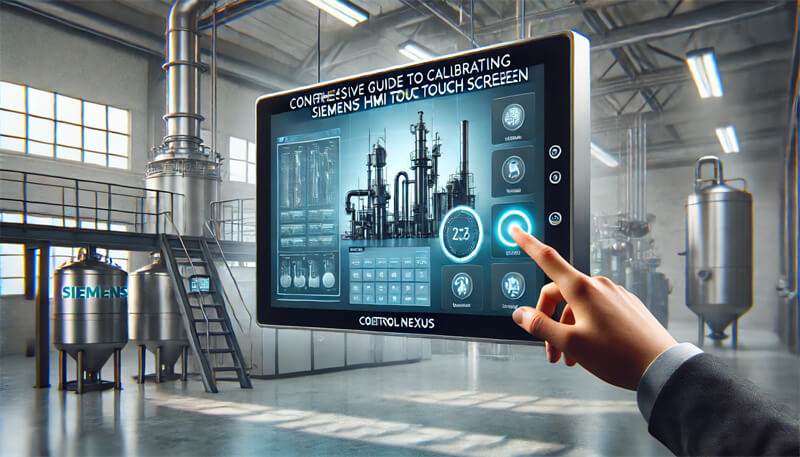Key Takeaways
| Topic | Summary |
|---|---|
| What is Calibration? | Calibration is the process of adjusting the touch screen to accurately detect touch points. |
| When is Calibration Needed? | Calibration is needed when the touch screen is not responding accurately or after replacing the touch screen. |
| Step-by-Step Calibration | Includes powering up the HMI, navigating to the calibration menu, and performing the calibration. |
| Common Issues and Solutions | Covers system card errors, HMIRTM.EXE errors, communication issues, and runtime license problems. |
| Expert Tips | Regular maintenance practices to prevent issues and enhance performance. |
Introduction
Siemens HMI (Human-Machine Interface) touch screens are essential components in modern industrial automation, offering intuitive control and monitoring of machinery. Proper calibration of these touch screens is crucial for ensuring accurate and reliable operation. In this comprehensive guide, we will explore the step-by-step process of calibrating Siemens HMI touch screens, troubleshoot common issues, and provide expert tips for maintaining optimal performance.
Understanding Siemens HMI Touch Screen Calibration
What is Calibration?
Calibration involves aligning the touch screen's input with the displayed output, ensuring that touch points are accurately detected. This process is vital for maintaining the precision and reliability of the HMI touchscreen.
When is Calibration Needed?
Calibration is typically required in the following scenarios:
- The touch screen is not responding accurately to touch inputs.
- The HMI touch screen has been replaced or repaired.
- The system indicates a need for calibration due to internal diagnostics.
Step-by-Step Calibration Process
Initial Setup
- Powering Up the HMI: Ensure the Siemens HMI is powered on and properly connected to the system.
- Navigating to the Calibration Menu: Access the HMI settings and locate the calibration menu. This can usually be found under system settings or touch screen settings.
Calibration Procedure
- Follow On-Screen Instructions: The HMI will display a series of points on the screen. Touch each point accurately as instructed.
- Confirm Calibration: After completing the touch points, confirm the calibration process. The HMI should now respond accurately to touch inputs.
Troubleshooting Common Calibration Issues
System Card Errors
- Understanding Memory Card Slots: Siemens HMIs like the TP1200 Comfort have two memory card slots, M50 and M51. The M50 slot is for system cards, while the M51 is for data storage.
- Resolving System Card Errors: If you encounter a "System Card Error", ensure the correct memory card is inserted in the appropriate slot. Deleting incompatible licenses from the system card and downloading the program again can also help resolve this issue.
HMIRTM.EXE Errors
- Common Causes: HMIRTM.EXE errors often occur when the alarm log reaches its maximum count.
- Solutions: Cut the alarm log to a new location to free up space. Reconfigure the historical data settings in the TIA Portal to prevent future occurrences.
Communication Issues Between PLC and HMI
- Setting Up TCP Communication: Ensure the HMI and PLC are within the same IP range. Properly configure the IP addresses and network settings.
- Ensuring Correct Configurations: Verify that the hardware configuration of the S7-1200 PLC and the HMI is correctly set up in the TIA Portal.
- Detailed Configuration Steps:
- IP Configuration: Ensure both the HMI and the PLC are set with IP addresses within the same subnet.
- Network Settings: Check the network view in the TIA Portal to confirm that the devices are properly interconnected.
- Firewall and Security: Verify that firewall settings on the network do not block the communication ports used by the HMI and PLC.
Runtime License Problems
- Understanding Licenses: Differentiate between WinCC RT Professional and Advanced Licenses. Each license type has specific requirements for running the HMI.
- Handling Power Tags: Ensure that the number of configured power tags does not exceed the license limit. Properly configure the runtime system to match the project requirements.
- Simulating Without a Runtime License: For testing and simulation purposes, it is possible to run the HMI without a full runtime license, although this might limit certain functionalities. Ensure that the simulation environment is properly configured to mimic the actual deployment as closely as possible.
- Updating and Managing Licenses: Regularly check for updates to the TIA Portal and WinCC software, as newer versions might offer improved functionality and better license management features.
Expert Tips for Maintaining Siemens HMI Touch Screens
- Regular Maintenance Practices: Regularly clean the touch screen and perform periodic calibration to maintain accuracy.
- Preventing Common Issues: Keep the firmware updated and ensure that all configurations are correctly set in the TIA Portal.
- Environmental Considerations: Place the HMI in a stable environment where temperature and humidity are controlled. Extreme conditions can affect the performance and lifespan of the touch screen.
- Backup Configurations Regularly: Periodically backup your HMI configurations to avoid data loss. This can be done using the TIA Portal or other Siemens backup solutions.
Frequently Asked Questions (FAQs)
How often should I calibrate my Siemens HMI touch screen?
Calibration should be performed whenever you notice inaccuracies in the touch response or after any maintenance involving the touch screen hardware.
What should I do if calibration does not resolve touch accuracy issues?
If calibration does not solve the problem, check for software updates or firmware upgrades for your HMI. Additionally, ensure that there are no physical obstructions or damage to the touch screen.
Can I perform calibration on all Siemens HMI models using the same method?
While the basic principles of calibration are similar, the exact steps might vary depending on the HMI model. Always refer to the specific user manual or documentation for your model.
Conclusion
Calibrating your Siemens HMI touch screen is a critical maintenance task that ensures accurate and reliable operation. By following the step-by-step guide provided, troubleshooting common issues, and implementing regular maintenance practices, you can extend the lifespan and performance of your HMI touch screens. For further assistance, detailed guides, and professional support, explore more about Siemens HMIs and related products at ControlNexus.
Stay updated with the latest advancements and best practices by visiting our blog. For any inquiries or personalized support, feel free to contact us.
For additional resources, including in-depth guides and product information, visit:
- Understanding Siemens PLC Data Types
- Mastering Siemens PLC Software: A Comprehensive Guide to SIMATIC STEP 7 and TIA Portal
- Comprehensive Guide to Connecting Your Siemens PLC with an HMI
Thank you for choosing ControlNexus, your trusted partner in industrial automation solutions since 2013.



